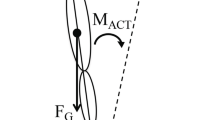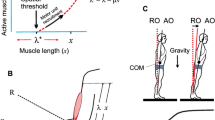Abstract
In addition to local biomechanical and reflex factors influencing muscle activation, global factors may be used by the nervous system to control all muscles in a coherent and task-specific way. It has been hypothesized that a virtual or referent (R) configuration of the body determined by muscle recruitment thresholds specified by neural control levels is such a factor. Due to the threshold nature of the R configuration, the activity of each muscle depends on the difference between the actual (Q) and the R configuration of the body. The nervous system modifies the R configuration to produce movement. One prediction of this hypothesis is that the Q and R configurations may match each other, most likely in movements with reversals in direction, resulting in a minimum in the electromyographic (EMG) activity level of muscles involved. The depth of the minima is constrained by the degree of coactivation of opposing muscle groups. Another prediction is that EMG minima in the activity of multiple muscles may occur not only when the movement is assisted but also when it is opposed by external forces (e.g., gravity). To verify these predictions, we analyzed EMG patterns of 16–21 functionally diverse muscles of the legs, trunk, and arms during jumping and stepping in place. One EMG minimum in the activity of all muscles regularly occurred near the apex of the jump. A minimum was also observed near the point of transition of the body from flexion to extension leading to a jump. During stepping in place, the activity of muscles of each side of the body was usually minimized near the beginning and near the end of the stance phase as well as during the maximum elevation of the foot. Since EMG minima occurred not only during gravity-assisted but also gravity-opposed movement reversals, it is concluded that neural factors (such as matching between the Q and R) rather than mechanical factors are responsible for minimizing the EMG activity in these movements.








Similar content being viewed by others
References
Adamovich SV, Levin MF, Feldman AG (1997) Central modifications of reflex parameters may underlie the fastest arm movements. J Neurophysiol 77:1460–1469
Archambault P, Levin MF, Mitnitski A, Feldman AG (1998) Multiple muscle co-ordination may be guided by a referent body configuration. Soc Neurosci Abstr 24:1158
Asytryan DG, Feldman AG (1965) Functional tuning of nervous system with control of movement or maintenance of a steady posture—I. Mechanographic analysis of the work of the joint on execution of a postural task. Biofizika 10:837–846
Beauséjour M, Aubin CÉ, Feldman AG, Labelle H (1999) Simulations de test d’inflexion latérale à l’aide d’un modèle musculo-squelettique du tronc. Ann Chir 53:742–750
Bernstein NA (1967) The coordination and regulation of movements. Pergamon, London
Capaday C (1995) The effects of baclofen on the stretch reflex parameters of the cat. Exp Brain Res 104:287–296
Feldman AG (1980) Superposition of motor programs—II. Rapid forearm flexion in man. Neuroscience 5:91–95
Feldman AG (1986) Once more on the equilibrium-point hypothesis (λ model) for motor control. J Mot Behav 18:17–54
Feldman AG, Levin MF (1995) The origin and use of positional frames of reference in motor control. Behav Brain Sci 18:723–806
Feldman AG, Orlovsky GN (1972) The influence of different descending systems on the tonic stretch reflex in the cat. Exp Neurol 37:481–494
Feldman AG, Levin MF, Mitnitski AM, Archambault P (1998) 1998 ISEK Congress Keynote Lecture: multi-muscle control in human movements. International Society of Electrophysiology and Kinesiology. J Electromyogr Kinesiol 8:383–390
Georgopoulos AP, Kalaska JF, Caminiti R, Massey JT (1982) On the relations between the direction of two-dimensional arm movements and cell discharge in primate motor cortex. J Neurosci 2:1527–1537
Georgopoulos AP, Ashe J, Smyrnis N, Taira M (1992) The motor cortex and the coding of force. Science 256:1692–1695
Graziano MS, Taylor CS, Moore T (2002a) Complex movements evoked by microstimulation of precentral cortex. Neuron 34:841–851
Graziano MS, Taylor CS, Moore T, Cooke DF (2002b) The cortical control of movement revisited. Neuron 36:349–362
Hasan Z, Karst GM (1989) Muscle activity for initiation of planar, two-joint arm movements in different directions. Exp Brain Res 76:651–655
Kugler PN, Kelso JAS, Turvey MT (1980) On the concept of coordinative structures as dissipative structures: I. Theoretical lines of convergence. In: Stelmach GE, Requin J (eds) Tutorials in motor behavior. North-Holland, New York, pp 3–47
Kugler PN, Kelso JAS, Turvey MT (1982) On the control and coordination of naturally developing systems. In: Kelso JAS, Clark JE (eds) The development of movement control and coordination. Wiley, Chichester, pp 5–78
Lacquaniti F (1992) Automatic control of limb movement and posture. Curr Opin Neurobiol 2:807–814
Lestienne FG, Thullier F, Archambault P, Levin MF, Feldman AG (2000) Multi-muscle control of head movements in monkeys: the referent configuration hypothesis. Neurosci Lett 283:65–68
Levin MF (2000) Sensorimotor deficits in patients with central nervous system lesions: explanations based on the λ model of motor control. Hum Mov Sci 19:107–137
Levin MF, Dimov M (1997) Spatial zones for muscle coactivation and the control of postural stability. Brain Res 757:43–59
Levin MF, Selles RW, Verheul MH, Meijer OG (2000) Deficits in the coordination of agonist and antagonist muscles in stroke patients: implications for normal motor control. Brain Res 853:352–369
Loeb GE, Levine WS (1990) Linking musculoskeletal mechanics to sensorimotor neurophysiology. In: Winters JM, Woo SLY (eds) Multiple muscle systems: biomechanics and movement organization. Springer-Verlag, New York, pp 165–181
Matthews PBC (1959) The dependence of tension upon extension in the stretch reflex of the soleus muscle in the decerebrated cat. J Physiol (Lond) 147:521–546
Nichols TR (1989) The organization of heterogenic reflexes among muscles crossing the ankle joint in the decerebrate cat. J Physiol 410:463–477
Nichols TR (1994) A biomechanical perspective on spinal mechanisms of coordinated muscular action: an architecture principle. Acta Anat (Basel) 151:1–13
Ostry DJ, Feldman AG (2003) A critical evaluation of force control hypothesis in motor control. Exp Brain Res 221:275–288
Rosenbaum DA, Engelbrecht SE, Bushe MM, Loucopoulos LD (1993) Knowledge model for selecting and producing reaching movements. J Mot Behav 25:217–227
Saltzman E, Kelso JA (1987) Skilled actions: a task-dynamic approach. Psychol Rev 94:84–106
Saltzman EL, Munhall KG (1992) Skill acquisition and development: the roles of state-, parameter-, and graph-dynamics. J Mot Behav 24:49–57
Scholz JP, Schoner G (1999) The uncontrolled manifold concept: identifying control variables for a functional task. Exp Brain Res 126:289–306
Scholz JP, Schoner G, Latash ML (2000) Identifying the control structure of multijoint coordination during pistol shooting. Exp Brain Res 135:382–404
Scholz JP, Reisman D, Schoner G (2001) Effects of varying task constraints on solutions to joint coordination in a sit-to-stand task. Exp Brain Res 141:485–500
Sergio LE, Kalaska JF (1998) Changes in the temporal pattern of primary motor cortex activity in a directional isometric force versus limb movement task. J Neurophysiol 80:1577–1583
Tax AA, Denier van der Gon JJ, Gielen CC, van den Tempel CM (1989) Differences in the activation of m. biceps brachii in the control of slow isotonic movements and isometric contractions. Exp Brain Res 76:55–63
Von Holst E, Mittelstaedt H (1950/1973) Daz reafferezprincip. Wechselwirkungen zwischen Zentralnerven-system und Peripherie. Naturwissenschaften 37:467–476, 1950. The reafference principle. In: The behavioral physiology of animals and man. The collected papers of Erich von Holst. Martin R (translator) University of Miami Press, Coral Gables, FL, pp 139–173
Weijs WA, Sugimura T, van Ruijven LJ (1999) Motor coordination in a multi-muscle system as revealed by principal components analysis of electromyographic variation. Exp Brain Res 127:233–243
Acknowledgements
The research was supported by grants from CIHR Canada, NSERC Canada, and FQRNT Québec. The authors thank Mindy Levin and David Rosenbaum for suggestions.
Author information
Authors and Affiliations
Corresponding author
Rights and permissions
About this article
Cite this article
St-Onge, N., Feldman, A.G. Referent configuration of the body: a global factor in the control of multiple skeletal muscles. Exp Brain Res 155, 291–300 (2004). https://doi.org/10.1007/s00221-003-1721-0
Received:
Accepted:
Published:
Issue Date:
DOI: https://doi.org/10.1007/s00221-003-1721-0




